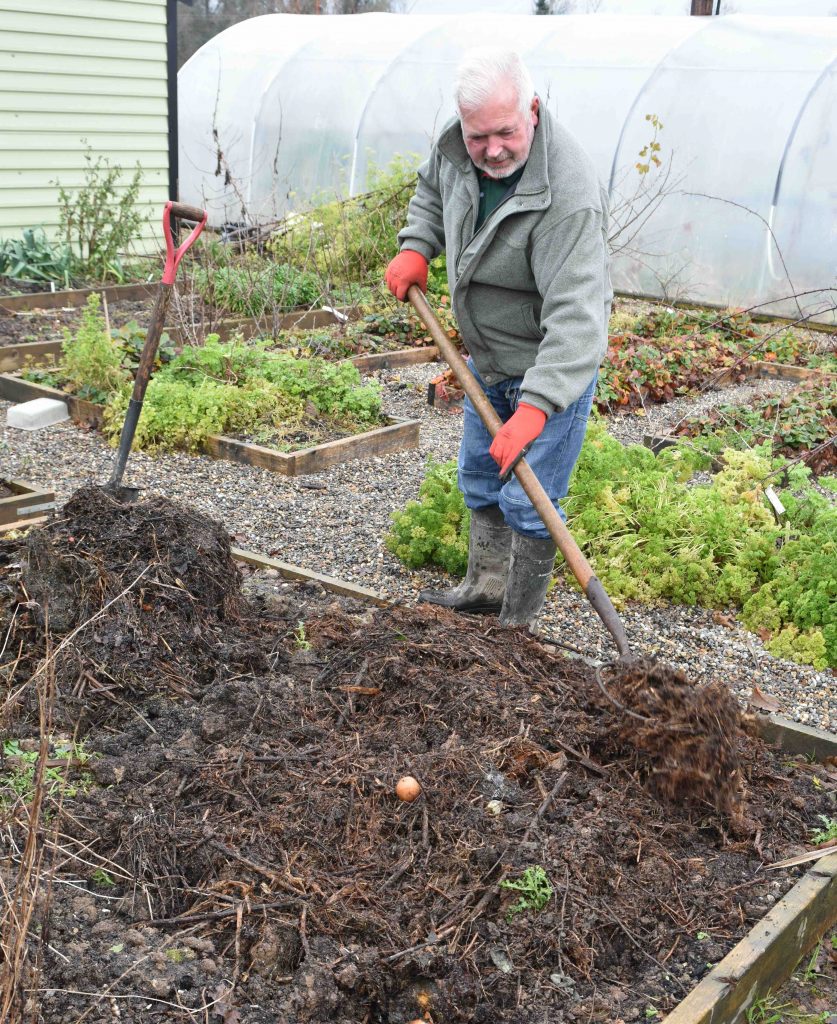
Winter is the traditional time to dig your plot. There are several reasons for this. The veg garden, where digging is more often an annual event, is often bare of crops. Digging and exposing the soil to frost can help improve the structure of clay soils. It is hard work and it is easier to do it in winter than in the heat of summer.
Many people question the need to dig and, with respect to such views, I follow my traditional training AND my experience and will say that it is necessary, at least when starting to make a garden.
Detractors say that digging disrupts the soil flora and fauna and it is beyond doubt that exposing the soil so areas dry out, will damage populations of micro-flora and will damage populations of worms and other creatures.
But digging also aerates soil, relieves compaction and allows the incorporation of organic matter. Worms will also take organic matter from the soil surface to deeper layers, but not as effectively, on heavy and unimproved soil, as a spade! My soil has many more worms now I have dug in tons of compost, though I do always get upset when I chop worms in half – though the robins are happy about it.
My own garden is being created from a field with compacted, unimproved soil and digging was, and is, essential, to get much to grow.

You do not need to dig over all your borders and mulching around many herbaceous plants and most trees and shrubs is all you need to do. But in the veg garden, where we expect good crops from the soil or with seasonal planting in the garden, digging is useful. Even if you have raised beds, although you may wish to just mulch and adopt ‘no-dig’ systems, digging at first is essential.
Raised beds have to be filled and that can be expensive and difficult. Bags of multipurpose compost are an expensive way to fill beds and not ideal. Bulk-buying topsoil is possible but it often introduces weeds. It is better to take your time and add organic matter and dig it in, gradually improving the soil you already have. Levels will slowly rise.
The simplest way to dig is just to spread your organic matter over the soil and turn over the soil and dig it in. The organic matter can be your own garden compost, well-rotted manure or leaf mould. You can also dig in straw or fallen leaves but these may encourage slugs and also cause nutrition problems in the short time.
You can also dig in some garden lime (available at Nags Hall) if your soil is heavy clay, or sprinkle it on the dug surface. Digging in sand will help improve clay soils.

While digging you can also remove the roots of perennial weeds and any perennial weeds. It is not easy to remove all the roots of ground elder (which are near the surface) or bindweed (which go much deeper) but you can, if careful, remove a decent amount. It is easier to dig out dandelion and dock roots.
Annual weeds, like chickweed and bittercress, can be dug in, but remember that there may be lots of weed seeds in the soil that will sprout in spring.

If you are digging a new bed, especially if it is for shrubs and will not be dug again, it may be worth ‘double digging’. This is hard work but it does get organic matter deep in the soil which will improve the soil, improve drainage and boost water-retention in summer. Basically you take out a trench and then fork organic matter into the lower levels. It is never a good idea to bring ‘subsoil’, often a different colour, to the surface, so this method improves the subsoil but leaves it low down.

Digging your soil now is best for heavy clay soils because you can leave the soil ‘rough’ and frost will break it up for spring. But exposing the dug, bare soil over winter can lead to soil nutrients being ‘leached’ by winter rain. While some nutrients will be added along with organic matter, it is usually best to leave the digging of light, sandy soils, which leach more readily than clay soils, till spring.
Adding organic matter will lighten clay soils and improve water retention and nutrient levels in light, sandy soils.
Some work now will get your veg beds ready for the busy spring season.
Digging tips
Take it easy: Pace yourself and don’t do too much in one go. Use a small spade if it makes things easier. A fork is easier in stony soil and a stainless steel spade is much easier on sticky, clay soils.
Avoid paddling about on the soil if it is very wet. Compacting wet, clay soils does more harm than good